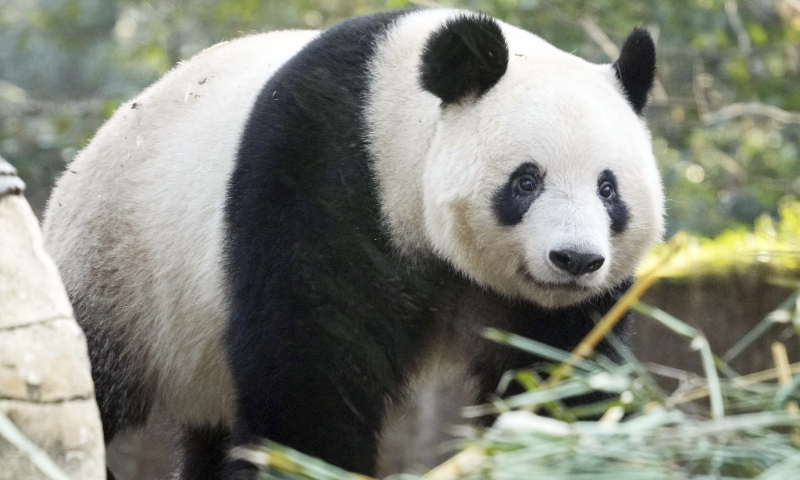
Giant panda XiangXiang is seen in Chengdu, Sichuan Province on February 18, 2024. Photo: VCG
A livestreaming event, sharing the recent condition of the hugely popular Japan-born female giant panda Xiang Xiang, was held simultaneously in Southwest China's Sichuan Province and Tokyo, Japan on Tuesday morning. This event took place over a year after Xiang Xiang departed from Tokyo's Ueno Zoo and settled down at the Bifengxia Giant Panda Base, a giant panda research and breeding facility in the city of Ya'an, Sichuan, on February 21, 2023.
Under the patient care of its breeders, Xiang Xiang gradually adapted to the environment of the Bifengxia base. It made its first public appearance at the base on October 8 last year and has since maintained unabated popularity among visitors from both China and Japan.
Chinese Ambassador to Japan Wu Jianghao addressed the event, stressing that cooperation on giant panda conservation and research serves as an important platform for people-to-people exchanges between China and Japan, playing a positive role in enhancing the friendly relations between the two countries.
Wu called for people from China and Japan to peacefully coexist, nurturing friendship across generations, engaging in mutually beneficial cooperation, and contributing to the healthy and stable development of China-Japan relations.
Xiang Xiang was born at Ueno Zoo in June 2017 to Shin Shin (female) and Ri Ri (male), two giant pandas on loan from China, where the ownership over the cubs they give birth to belongs. As the first panda naturally bred and raised at the zoo in nearly three decades since You You, born in 1988, Xiang Xiang gained huge popularity among Japanese people.
During the event, Zhao Lanlan, Xiang Xiang's breeder at the Bifengxia base, assured panda enthusiasts from China and Japan that the giant panda has basically adapted to the environment and climate in Bifengxia base, the location of which is so close to nature, and Xiang Xiang can enjoy an entire hill. It has also gotten used to the feeding and management mode at the base.
According to Zhao, Xiang Xiang has made impressive progress over the past year from its initial timid and sensitive response to sounds and running away from unfamiliar noises to its present ability to face the public calmly and eat its food on the feeding platform, without hiding away from the public after its meals to take a rest any more.
During the event, panda enthusiasts from both China and Japan were able to watch Xiang Xiang leisurely sitting on the ground, enjoying fresh bamboo with relish without interruption via livestreaming, showcasing a particularly hearty appetite.
According to Zhao, Xiang Xiang particularly likes apples. Usually, the breeders feed her 30 kilograms of fresh bamboos, 400 grams of apples, 1 kilogram of steamed corn buns and 3 kilograms of bamboo shoots on average every day.
A Japanese panda lover present at the event was very concerned on whether Xiang Xiang is still so picky about food since Xiang Xiang refused to eat carrots when it was in Japan. Zhao told her that Xiang Xiang still does not eat this vegetable though Zhao had tried various methods, including making carrot hamburgers, to lure her to eat the nutritious vegetable.
According to the Agreement on Cooperation in the Implementation of Giant Panda Protection Research signed between the Tokyo Metropolitan Government and China Wildlife Conservation Association, Xiang Xiang was originally scheduled to be returned to China by the end of December of 2020. However, due to multiple factors such as the COVID-19 epidemic, Xiang Xiang, who has reached maturity and is ready to mate, finally returned to China where she is set to start her search for a mate last year after five extensions.
Many panda enthusiasts have been caring about whether Xiang Xiang's husband had been decided.
According to Zhao, the selection of mate for Xiang Xiang will be based on the overall arrangement by China's National Forestry and Grassland Administration, as well as the evaluation on the pairing coefficient of the giant panda population. Pairing should be optimized but not solely based on estrus. Currently, Xiang Xiang has not been involved in the breeding program.
Zhao also expressed her sentiments as the first breeder of Xiang Xiang upon its return to China. She described Xiang Xiang as smart and quiet, expressing her wish for Xiang Xiang to lead a carefree life and hoping that panda enthusiasts from Japan could visit her in Sichuan.
During the event, Yasumasa Tomita, deputy director of Ueno Zoo, also shared his experience of accompanying Xiang Xiang to return to Sichuan, and a Japanese giant panda enthusiast Takahata Tomoka told her story about how she had participated in naming Xiang Xiang.
Wu Hailong, president of the China Public Diplomacy Association, addressed the event saying that Xiang Xiang is not only a giant panda, but also a bond of friendship between the people from China and Japan.
Global Times




